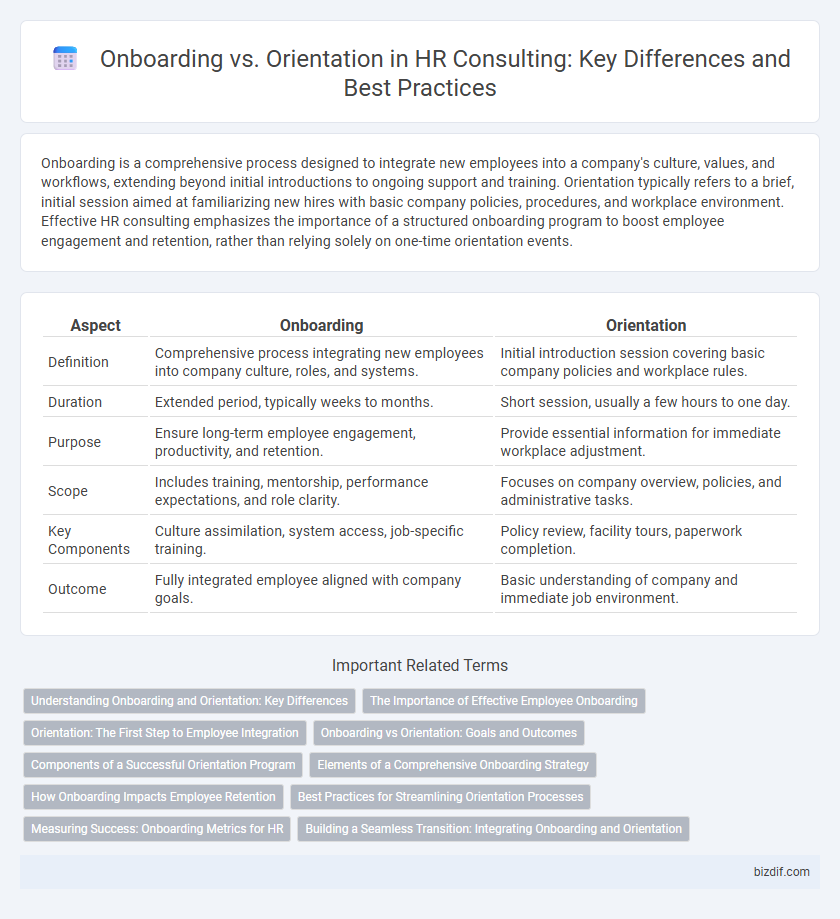Onboarding is a comprehensive process designed to integrate new employees into a company's culture, values, and workflows, extending beyond initial introductions to ongoing support and training. Orientation typically refers to a brief, initial session aimed at familiarizing new hires with basic company policies, procedures, and workplace environment. Effective HR consulting emphasizes the importance of a structured onboarding program to boost employee engagement and retention, rather than relying solely on one-time orientation events.
Table of Comparison
| Aspect | Onboarding | Orientation |
|---|---|---|
| Definition | Comprehensive process integrating new employees into company culture, roles, and systems. | Initial introduction session covering basic company policies and workplace rules. |
| Duration | Extended period, typically weeks to months. | Short session, usually a few hours to one day. |
| Purpose | Ensure long-term employee engagement, productivity, and retention. | Provide essential information for immediate workplace adjustment. |
| Scope | Includes training, mentorship, performance expectations, and role clarity. | Focuses on company overview, policies, and administrative tasks. |
| Key Components | Culture assimilation, system access, job-specific training. | Policy review, facility tours, paperwork completion. |
| Outcome | Fully integrated employee aligned with company goals. | Basic understanding of company and immediate job environment. |
Understanding Onboarding and Orientation: Key Differences
Onboarding is a comprehensive process that integrates new employees into an organization by providing them with company culture, role-specific training, and performance expectations over an extended period. Orientation, in contrast, is a brief introduction typically lasting one or two days, concentrating on administrative tasks, policy reviews, and basic workplace information. Understanding these key differences helps HR consulting firms design tailored programs that enhance employee engagement and retention from day one.
The Importance of Effective Employee Onboarding
Effective employee onboarding significantly enhances retention rates, boosts productivity, and accelerates new hire integration by providing comprehensive training and clear role expectations. Unlike orientation, which is a brief introduction to company policies and culture, onboarding encompasses continuous support and development tailored to employees' specific roles. Implementing structured onboarding programs reduces turnover costs by up to 50% and fosters long-term engagement and job satisfaction.
Orientation: The First Step to Employee Integration
Orientation serves as the critical first step in employee integration by familiarizing new hires with company culture, policies, and team dynamics. It establishes clear expectations and provides essential resources, ensuring a smooth transition into the organization. Effective orientation programs increase employee engagement and retention by building confidence and fostering a sense of belonging from day one.
Onboarding vs Orientation: Goals and Outcomes
Onboarding aims to integrate new employees into the company culture, ensuring they understand their roles, expectations, and have access to necessary resources for long-term success. Orientation typically focuses on providing essential information about company policies, benefits, and administrative procedures during the initial days. Effective onboarding results in higher employee engagement, retention, and productivity, while orientation serves as an introductory step to facilitate this process.
Components of a Successful Orientation Program
A successful orientation program includes clear communication of company policies, an introduction to organizational culture, and comprehensive training on job-specific tasks. Engaging new hires with interactive sessions and providing access to supportive resources enhances employee retention and productivity. Structured feedback mechanisms during orientation ensure continuous improvement and alignment with company goals.
Elements of a Comprehensive Onboarding Strategy
A comprehensive onboarding strategy integrates structured training, clear role expectations, and cultural assimilation to enhance employee engagement and retention. Key elements include personalized learning plans, mentorship programs, and continuous feedback mechanisms that extend beyond initial orientation. Effective onboarding aligns new hires with company goals, fosters relationships, and accelerates productivity within the critical first 90 days.
How Onboarding Impacts Employee Retention
Effective onboarding programs significantly enhance employee retention by providing new hires with clear role expectations, access to essential resources, and a sense of belonging within the company culture. Research shows that employees who experience structured onboarding are 69% more likely to remain with an organization for at least three years. By focusing on comprehensive onboarding processes rather than brief orientation sessions, HR consulting firms help businesses reduce turnover costs and improve long-term workforce stability.
Best Practices for Streamlining Orientation Processes
Effective onboarding integrates comprehensive orientation with role-specific training to enhance employee engagement and retention. Streamlined orientation processes leverage digital tools such as automated checklists, e-learning modules, and virtual introductions to reduce administrative burdens and accelerate productivity. Consistent feedback loops and tailored content based on job functions optimize new hire experiences and foster quicker cultural assimilation.
Measuring Success: Onboarding Metrics for HR
Key onboarding metrics for HR include employee engagement scores, retention rates within the first 90 days, and time-to-productivity benchmarks. Tracking new hire performance evaluations against preset goals provides insight into onboarding effectiveness. These data points enable HR teams to refine onboarding processes and improve overall talent integration.
Building a Seamless Transition: Integrating Onboarding and Orientation
Building a seamless transition between onboarding and orientation enhances employee engagement and accelerates productivity. Effective onboarding integrates comprehensive orientation programs that address role clarity, company culture, and key relationships. Streamlined processes support continuous learning and foster a sense of belonging from day one.
Onboarding vs orientation Infographic

 bizdif.com
bizdif.com